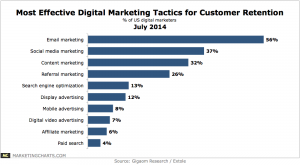A new Marketing Charts came to my email this week.
Facebook has investors. When you have to pay share holders you always need to be generating more revenue. Facebook has become increasingly more commercialized since it’s IPO. Now a company’s Facebook posts will get to 6% or less of their fans! Ridiculous! Organic reach has been significantly dropping (via Tech Crunch):
- Feb 2012 = 16%
- Sep 2013 = 12.60%
- Nov 2013 = 10.15%
- Dec 2013 = 7.83%
- Mar 2014 = 6.51%
Why does Organic reach drop? So you can spend money to reach the fans you have worked hard to collect.
But this should be a  warning to all marketers for all social channels. Social Media networks control the flow of information. They will use that control after gaining our dependence for marketing. Twitter just proudly told everyone that 30% of a company’s followers will see their posts. I am predicting this will begin to drop as the need for revenue increases. After all Twitter has only been publicly traded for less than a year. It is conceivable that they will take a similar course as Facebook.
This is why email will become more and more crucial to marketers. Email does not require a channel owned by a interested party. The only thing that keeps your open rate low is the quality of your list and the quality of your content.
It is up to you.
Maybe that is the scary part but it is also the easiest to fix.
Kevin

